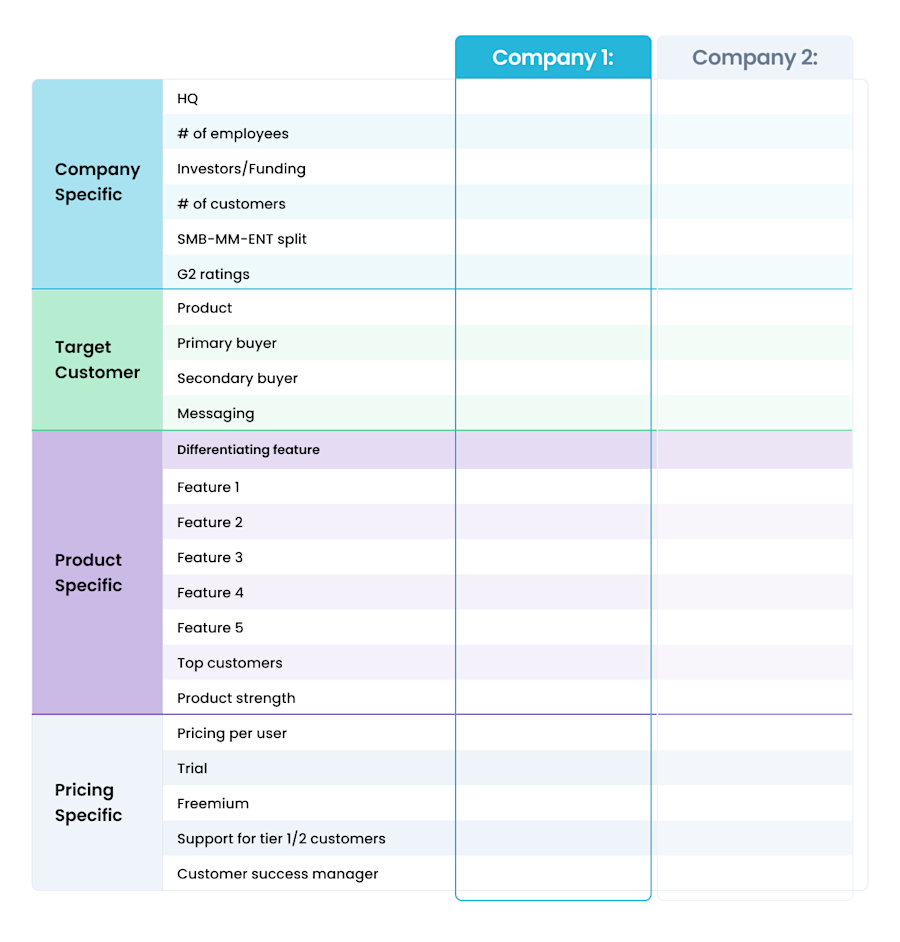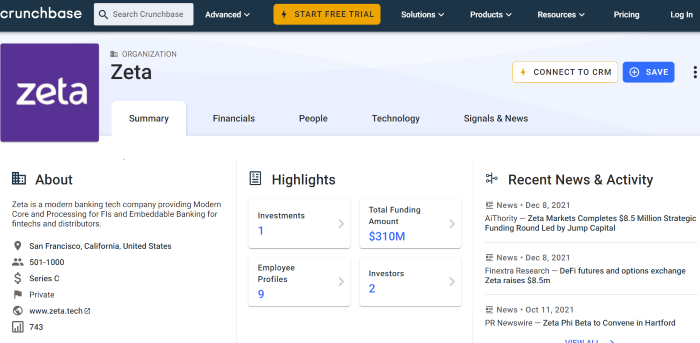We like to think we know our competitors.
Maybe you follow their social channels and keep an eye on their blog.
That might not be enough.
When was the last time you took a deeper look? Are they launching a new feature that could tank your market share? Are they building a huge following on LinkedIn?
What about new target keywords? Are they producing content on a topic that seems unrelated to their current offering? What does that mean?
The only way to stay ahead of the competition is to make sure you're paying attention.
As the product marketing manager at Leadfeeder, my team and I keep a close eye on new features and product rollouts that could impact us. Today, I'll share our strategy to perform an in-depth competitor analysis in the B2B space.
To make the process easier, I've added a competitive analysis template you can use to streamline the process.
Note: Leadfeeder identifies visitors to your website — even if they don't fill out forms or join your newsletter list. Sign up for a free trial or learn more here.
What is a competitor analysis?
A competitor analysis is an in-depth look at who your competitors are, what sales and marketing practices they use, and where they find success in your market.
This information helps identify strengths and weaknesses in your strategies and locate new growth opportunities.
For example, you might look at:
What key terms they target
What type of content they publish
Who their clients are
What products they offer
What features each product has
Their sales process
How often they post content, including on social media
What lead magnets they use
How they price their offering
As you can see, a competitive analysis covers a lot of ground. Why should you invest time in this research?
Why should I perform a competitor analysis?
The core purpose of a competitive analysis is to understand your competition's strengths and weaknesses. This can help you locate gaps in the market — so you can fill them.
A great competitive analysis tells you more than whether your pricing is on point or if you're targeting the right keywords.
In fact, it can impact every part of your business, including marketing, sales, customer service, and product development.
Here are a few ways to leverage competitive analysis data:
SEO: Track which keywords they are targeting, where they get backlinks from, and what technical SEO strategies are paying off.
Content: What topics is your audience interested in? What content formats are taking off this year? How often should you publish on your blog? Paying attention to your competitors can help you develop a more effective content strategy.
Social media: Pay attention to where your competitors post, who they target, and what type of content gets attention. You might even find a new target market or a better time to post.
UI: User interface can make or break your product. You look at your product everyday, which means you know how it works, which tabs to click, etc. Paying attention to UI trends your competitors leverage helps you create a better product.
Product development: Paying attention to what products and services your competitors offer helps you create a better product roadmap for your brand. This isn't about copying the competition, but paying attention to how it might impact your launch, rebrand, new marketing initiative, etc.
You've probably heard the phrase "know thy enemy."
The full quote is "If you know the enemy and know yourself, you need not fear the result of a hundred battles."
Okay, so B2B might not be a battlefield. But knowing your competition is still crucial to long-term success.
How to perform a competitive analysis (with a template)
A competitive analysis isn't something you can wing and to do it right, you need a process.
Even more, you need a repeatable process so you can stay up to date and track long-term trends.
That's why we've created this template:

If you follow this, you'll have all the information you need to get an edge over your competitors.
Below, I'll explain what information to include in each section and why that data matters.
Company information
In the company information section, add information about who the company is from the outside. When they were founded, how many employees they have, how much funding they have, where they are in the market (SMB, MM, or ENT), and ratings on sites like G2.
You can get this information on their website, news websites, and sites like Crunchbase.

What this information tells you:
Company size can give your competitors a huge advantage. If you have a team of 10 and they're an enterprise company with 500+ employees, there are some areas you won't be able to compete.
Which doesn't mean you should throw in the towel, but you may need to focus more on finding gaps in the market.
Funding is significant, especially if they recently got a round of funding or are preparing for a round of funding. If you can get an edge before they secure funding, you're likely to maintain that edge.
Target customers
Next, we look at target customers or target audiences. Who are they targeting for each product? Do they have a primary and secondary customer base?
To find this information, head to their website. Does their navigation bar have a drop-down menu with different markets? They might offer resources on their product page for other markets, as Slack does:

Look at their educational resources and see if those are split into different categories for different markets.
For example, we offer training and resources for both sales and marketing teams because those are our two primary audiences.

Finally, look at their reviews and case studies to see what type of customers they highlight.
Your competitors might offer three to four products, each with three to four different target markets, like SMB or enterprise. Or, they might target both freelancers and marketing agencies.
Note this information, and add additional sections to your template if you need to.
What this information tells you:
Studying your competitor's market can highlight opportunities to expand your own audience. For example, if you primarily target one country, but your competitor targets two or three, it might be time to expand.
Pay special attention to changes in the content they produce. If no one in your industry targets SMB, and your competitor starts creating content for SMB, they might have a new product or feature in the works for that target audience. 🔬
Product and feature offerings
Next, take a look at what products and features they offer. This step is the most time-consuming, but it can also provide the most information. Note each type of product they offer and then the features of each product.
You can find this information on their website or on sites like G2 and Capterra. You may need to sign up for a free trial or free version to get a deeper look at the features.
Also, ask your sales team to pay attention to what prospects say about your competitors. For example, they might mention "Oh, <competitor> said this feature or integration will be out in a few months."
This crucial information can help you adjust your product roadmap or guide your SEO/PPC strategy.
Make a list of the features your tool offers so you can highlight where your product stands out. This is the list we use when comparing features with our competitors:

There are some features, like specific integrations and video tracking that many of our competitors don't offer.
What this information tells you
Comparing features and product information highlights where your tool stands out — or falls short. If your competitors offer integrations or features you don't, it might be time to add those to your development timeline.
On the other hand, if you have features your competitors lack, use those as a differential advantage in sales and marketing efforts.
Look at pricing
Finally, it's time to look at pricing. How much do you charge and how much do your competitors charge?
Don't just look at the surface numbers — consider features, discounts for yearly vs monthly plans, and the limits of each plan.
What this information tells you
Comparing pricing can tell you how much the market will bear pricing-wise. It can also help you adjust your sales and marketing approaches.
If your product is more expensive but offers more features, make sure to focus on the value you offer over your competitors.
If your pricing is cheaper or more transparent on pricing, highlight that benefit.
For example, many lead generation tools like ours make prospects contact them for a quote. We think being transparent about pricing is a better approach, so we highlight that in our marketing messages.
Are your competitors spying on you? Find out with Leadfeeder
If you're spying on your competitors, there's a good chance they're spying on you.
Want to see when they check out your website? Create a custom feed to track when your competitors visit your site, track what pages they view, and how long they stay on each page. You can even set custom notifications, so you get an email or Slack message when your competitors are creeping on your site. 👀
Note: Sign up for a free 14-day Leadfeeder trial or learn more about our lead generation features here.
Now that you're here
Leadfeeder is a tool that shows you companies that visit your website. Leadfeeder generates new leads, offers insight on your customers and can help you increase your marketing ROI.
If you liked this blog post, you'll probably love Leadfeeder, too.
Sign up







